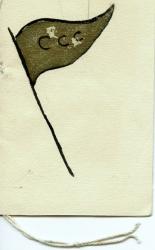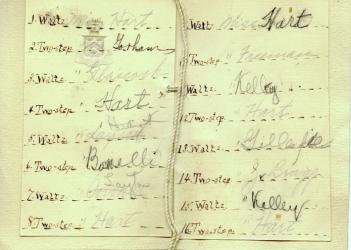Waltz or Two Step
In 1907 and 1908, William Arlitt, a student at Georgetown University, attended a number of dances and parties at Chevy Chase College and perhaps because he enjoyed them so much, he kept his dance cards as souvenirs. Each small card in his scrapbook has a list of waltzes and two-steps. Young Mr. Arlitt always seemed to have a full dance card. He must have been a favorite of several Chevy girls during those two years, for he kept the invitations sent to him by Mrs. Barker. A page of his scrapbook shows some of these invitations, as well as a photo from a candy pull, held in the lower level of the main building, a room also known as “The Cave.” These dances and parties suggest the chaste and wholesome environment that Dr. and Mrs. Barker promoted at the school. With no other evidence, we can only imagine the excitement of these events for both the Chevy girls and the boys who attended them.


Arlitt Dance Card, January 2, 1908, CCHS 500.14.26
“Tango Puzzle”
While all of the dances at the school must have been keenly anticipated, one in December 1913 made the pages of The Washington Post with this headline:
A dance craze swept the nation in these years, including the dangerously sensuous tango. A version of the tango, minimizing physical contact, was introduced by Norman and Irene Vernon, but many conservative observers still found it too suggestive. In addition, with the introduction of ragtime music came a series of “animal dances,” or what some called “freak dances.” These included the bunny hug, the turkey trot and the fox trot, which were banned at Chevy Chase School as well as the nearby Chevy Chase Lake Amusement Park.
But the story about the upcoming dance at the Chevy Chase centered on a dilemma posed by a restriction printed on the invitations sent to the George Washington students: “Any extreme form of dancing or familiar attitude assumed by many in the present-day dances is disapproved by the faculty.” The problem arose because George Washington University had just recently lifted their own ban on such dances (with the exception of the turkey trot), so now everyone wondered what would happen at the dance. Would the dancers be restricted to the waltz and the two-step? We don’t know how this particular evening turned out, but gradually the “modern” dances were accepted, and by the twenties, the fox trot became standard in ballrooms and dance floors across the nation.


